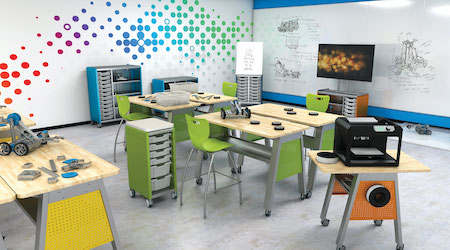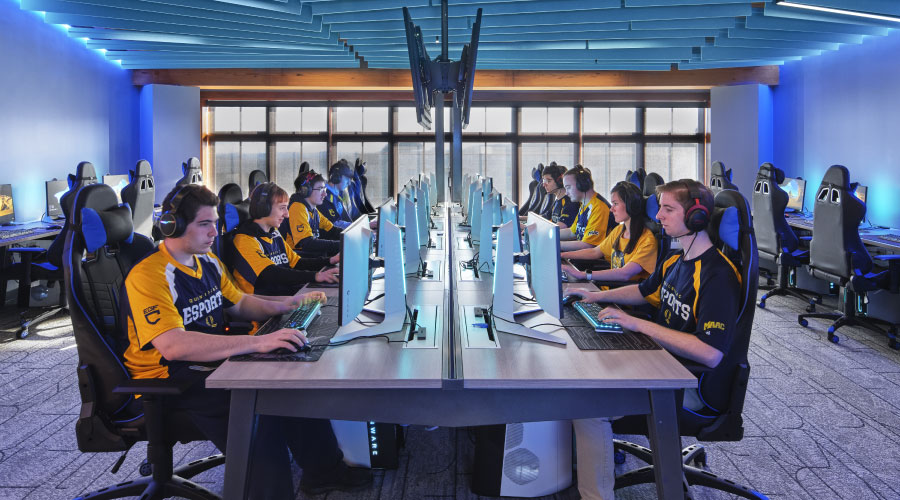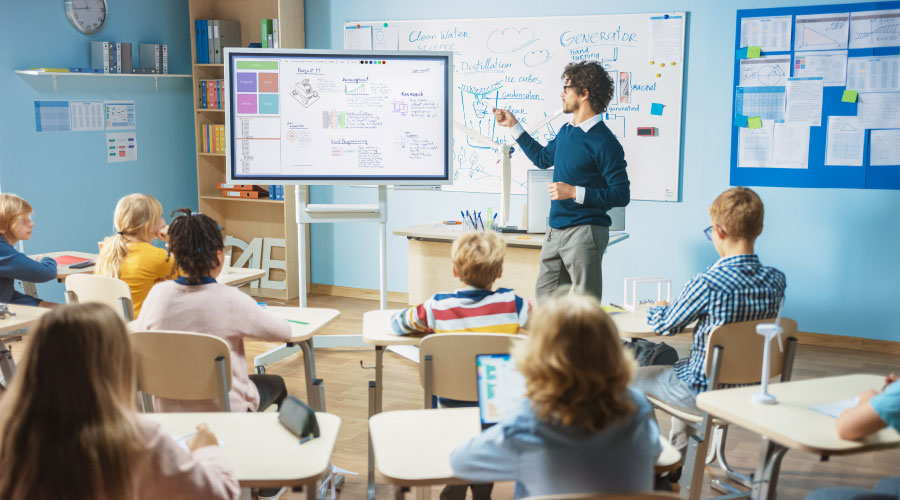How to Design the Post-Covid Classroom
A recent survey illustrated how school facilities strategies are shifting as a result of the pandemic.
The classroom as we once knew it has dramatically changed in the past two years. Nearly all classes have returned to in-person study, but remaining COVID concerns and a new outlook on wellness have reshaped the way that teachers are looking at their spaces.
A recent survey of 140 K-12 teachers from nearly every U.S. state sought to identify how today's educators are navigating the new normal. This Classroom of the Future poll revealed that teachers are getting creative to make sure that their students are happy and healthy when they're in class.
The Case for Space
Nearly half (46 percent) of all teachers have increased space between seating, whether that's in the aisles between traditional desking or with flexible solutions such as stools or floor rockers. Only 20 percent of classrooms have reported limited seating capacity, leading many educators to find creative ways to rearrange their spaces. For the time being, teachers are turning away from pods and leaning towards rows and columns, but many of today's table desks are able to easily move between configurations whenever necessary.
That doesn't mean that these well-spaced solutions can't be exciting for students. We have also seen 35 percent of teachers incorporating more flexible seating solutions, such as stools at standing-height desks, rolling desk chairs, and wobbling seating to alleviate fidgeting.
It Starts with Storage
Bulky storage pieces are quick to take up valuable classroom space. There's no one-size-fits-all solution, but there's always options for every area:
- Move to the Perimeter: Place your storage units to the back of the classroom or against side walls to make more open space to place seating.
- Make it Mobile: Carts with casters give you the opportunity to keep your supply storage out of the way when it's not in use and front-and-center when only when it's needed.
- Look Up: Instead of short, squat cabinets, use taller units that offer more storage space without a larger footprint.
- Have fun: Storage doesn't always have to be drab. Colorful bins on open-air bookshelves or classroom decorations on the outside of cabinets can make a larger storage piece fit seamlessly into your classroom décor scheme.
Make Wellness a Priority
Wellness strategies come in all shapes and sizes. They're geared both towards student safety as well as making sure that mental health is at the forefront of the school day. Kids are often overwhelmed by world events and changes, making it important to have quiet spaces for students to decompress, such as a "calm down corner" or privacy booths to give them room to breathe.
A clean classroom is a healthy classroom. With COVID-19 still a concern, classrooms need to have hand sanitizer at the ready and easy-to-clean surfaces that can be quickly wiped down with disinfecting wipes before other students use them. Make it easy for them to take control of their own wellbeing by keeping ample stocks of supplies and encouraging them to clean behind themselves when necessary.
Go Mobile
These days, most classroom furniture can be outfitted with casters to create a mobile, modular solution:
- Student Desks: With different shapes, sizes, and heights available, many student desks are available with locking casters to make it easy to space out desks or bring them together when it's safe to collaborate.
- Mobile Lecterns: For teachers, a mobile podium makes it easy to teach from any area of the classroom. Smaller more nimble carts are designed to hold important supplies without taking up too much space in tight areas.
- Boards: From smart boards to regular white boards, you can make sure that your students can clearly see the tasks at hand when you can arrange the writing surfaces as necessary.
- Storage: Clever carts are an easy way to make sure that storage solutions are out-of-the-way when not in use, adding valuable space to your classrooms. These can even be as advanced as laptop or Chromebook charging stations with the right features to keep technology safe and powered up.
Embrace Technology
Even before virtual learning, laptops and Chromebooks have become mainstays of today's classroom. To help integrate technology into your classroom, make sure there's ample access to power throughout the room. Mobile towers that can be rolled out as needed, integrated power ports, and dedicated charging stations make it easy to navigate long hours in a classroom that's more tech-heavy than ever before.
Above all else, students and teachers have proven themselves to be flexible and adaptable, even in the most complicated situations. The right tips, tricks, and tools can make it even easier to embrace the classroom of the future and make it your own.
Download this free eBook on creating wellness-oriented workspaces that features more exciting tips and tricks to improve your educational facility.
Joanna Terry, is the director of education space planning at National Business Furniture.
Related Topics:












